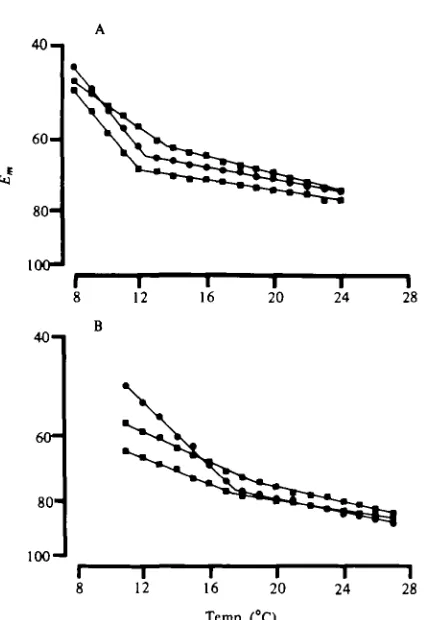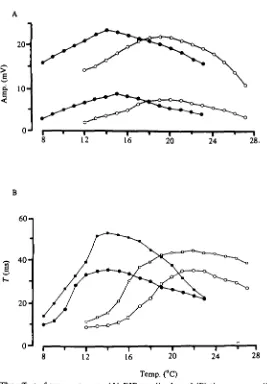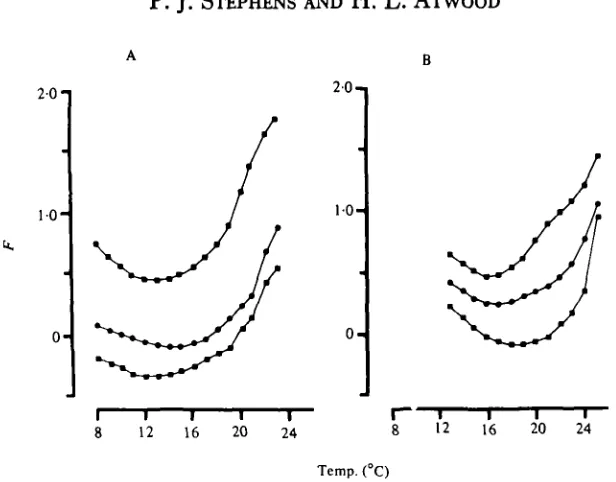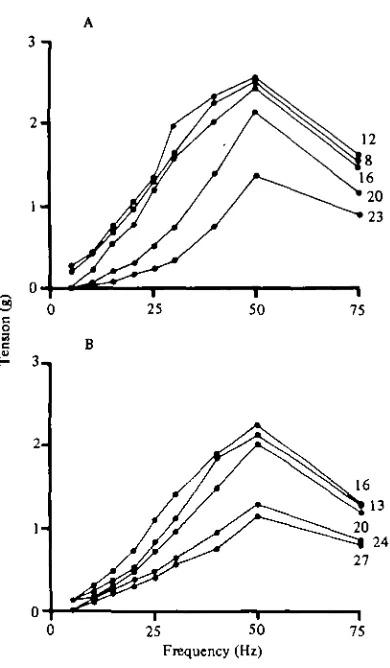NEUROMUSCULAR SYSTEM
BY PHILIP J. STEPHENS1 AND HAROLD L. ATWOOD
University of Toronto, Department of Zoology, Toronto, Ontario M$S 1A1
{Received 5 August 1981 - Accepted 15 January 1982)
SUMMARY
1. Effects of temperature on the muscle fibre membrane and synapses of stretcher muscle preparations made from autotomized limbs of the Pacific shore crab (Pachygrapsus crassipes) were investigated.
2. Acclimation of the crabs to different temperatures modified properties of both muscle fibre membrane and synapses.
3. Increased temperature produced an increase in membrane potential of the muscle fibres. A semi-log plot of these data revealed two linear phases of the membrane potential-temperature relationship, with a change in slope near the acclimation temperature.
4. Maximum values for excitatory junction potential (EJP) amplitude and time constant of EJP decay, and minimum values for facilitation were ob-tained at temperatures close to the acclimation temperature. It is suggested that the decline in EJP amplitude and time constant of decay produced by deviations in temperature from the acclimation temperature is compensated for by an increase in the amount of facilitation. In this way, maximum tension can be produced by the stretcher muscle in a range of at least 8 °C around the acclimation temperature.
INTRODUCTION
The body temperature of most cold-blooded animals, or poikilotherms, is dependent upon the temperature of the environment. Certain environments provide near constant thermal conditions and permit cold-blooded animals to maintain stable body temperatures. Physiological and behavioural observations made on poikilotherms from such thermally stable environments have revealed limited tolerance to sudden temperature changes (Hammel, Stromme & Myrhe, 1969; Florey & Hoyle, 1961, 1976). By contrast, other poikilotherms live in environments with dramatic thermal fluctuations, both short term (on a daily basis) and long term (on a seasonal basis). These animals must tolerate and adapt to the temperature changes in order to main-tain functional integrity.
In the crayfish, a poikilotherm that lives in a thermally fluctuating environment, neuromuscular systems function over a wide temperature range. Rapid alterations in
1
40 P. J. STEPHENS AND H. L. ATWOOD
Fig. i. Diagram of a preparation made from an autotomized walking limb. Stimulus shocks (S) were applied to bundles of the exposed limb nerve (L) in the meropodite, and evoked junc-tional potentials were recorded (R) via microelectrodes in single stretcher muscle fibres. Scale: i cm.
temperature provoke changes in membrane potential, and changes in amplitude, time course, and facilitation of the junction potential (Harri & Florey, 1977). These re-sponses can be modified by prior acclimation of the crayfish to different temperatures (Harri & Florey, 1979). In fish, thermal acclimation has a profound effect upon the saturation and fluidity of synaptosomal membrane lipids (Roots & Johnston, 1968; Driedzic, Selivonchick & Roots, 1776; Cossins, Friedlander & Prosser, 1977; Matheson, Oei & Roots, 1980). It has been suggested that, in crayfish, thermal acclimation modifies membrane and synaptic properties by influencing membrane lipid composition (Harri & Florey, 1979).
In the present paper, we report observations on the single excitatory motor axon that innervates the stretcher muscle in walking legs of the shore crab, Pachygrapsus crassipes. Previously, we reported that short term changes in temperature produce changes in muscle fibre membrane and synaptic properties (Atwood & Stephens, 1980). Here, we report that these responses are modified by acclimation of the crabs to different temperatures.
MATERIALS AND METHODS
Shore crabs (Pachygrapsus crassipes) were obtained from the Pacific Biomarine Laboratories in Venice, California, and were retained individually at 12 °C (cold acclimation) or 21 °C (warm acclimation). Feeding (Purina fish chow) and changes of artificial seawater were performed twice a week. Under these conditions the crabs lived for at least 6 months.
Fig. 2. Calculation of facilitation (F). A photograph taken directly from the signal averager of two superimposed traces showing a single EJP and a pair of EJP's (separated by 25 ms) recorded from a stretcher muscle fibre. Each trace represents the mean response of 32 successive sweep*. EJP amplitudes (yx and V,) were corrected for summation (see text). Calibration: 2 mV and
10 ms.
used to deliver single stimulating pulses, or pairs or trains of pulses (o-i ms duration) to a bundle containing the E axon (Fig. 1). A small window was drilled in the distal portion of the carpopodite and the exposed stretcher muscle fibres were penetrated with glass microelectrodes filled with 3 M-KCl (3 to 15 M£2). Values for the membrane potential of single muscle fibres were obtained from a digital voltmeter. Excitatory junctional potentials (EJP's), evoked by E axon stimulation, were displayed and photographed on an oscilloscope. EJP amplitude, and time constant (defined as the time taken for the EJP to decline from peak amplitude to 1 /e of peak amplitude) were measured with a signal averager (Fabritek Instruments Inc., Model 1072).
Measurements of facilitation were made by applying pairs of stimuli (at an inter-pulse interval of 25 ms) to the E axon and using the signal averager to analyse the mean of 16 response-pairs. Mean amplitudes of EJP's were measured as shown in Fig. 2 and corrected for non-linear summation (Martin, 1955), using a value for reversal potential of o mV (Taraskevich, 1971; Takeuchi & Onodera, 1973). The relatively slow time course of the EJP made it unnecessary to apply further corrections. The degree of facilitation (F) was calculated using the equation:
F =
Two EJP's with the same amplitude produce an F value of o. A positive F value denotes facilitation, whereas a negative F value is obtained when the second EJP is smaller than the first, and reflects de-facilitation or depression.
Tension produced by the whole stretcher muscle was measured with a force-displacement transducer (Grass FT. 03) attached to the propodite. The E axon was stimulated with 1-5 second trains of electrical shocks at frequencies between 5 and 75 Hz. The amplified signals were photographed on an oscilloscope.
P. J. STEPHENS AND H. L. ATWOOD
40-i
6 0
-
80-1(XH
40-i
6 0
-
801 0 0
-8 12 16
B
20 24 28
8 12 16 20 24 28I
Temp. (°C)
Fig. 3. T h e effect of temperature on the membrane potential (Em) of stretcher muscle fibres in
3 cold (A) and 3 warm (B) acclimated preparations. T h e semi-log plot shows two linear com-ponents. All correlation coefficients were > 0 9 .
were made at about 0-2 °C/min and observations were made after a period of at least 5 min at the test temperature.
RESULTS
Cold-acclimated preparations (acclimated to 12 °C) were cooled to 8 °C and observa-tions made during subsequent wanning to 23 °C. Warm-acclimated (21 °C) prepara-tions were cooled to 13 °C and then warmed to 27 °C. The lower limit of each temper-ature range was chosen to avoid irreversible change in EJP amplitude, which occurred at 6 °C in cold-acclimated preparations and at 11 °C after warm acclimation. Upper limits were chosen to keep the temperature below the critical threshold at which a single orthodromic action potential in the E axon generated additional spikes in the periphery (Stephens & Atwood, 1981).
Membrane potential
[image:4.451.112.325.69.379.2]9
6.
12 16 20 24 28,
60-i
40 A
20 A
0-1
12 16 20 24 28
[image:5.451.83.350.73.457.2]Temp. (°O
Fig. 4. The effect of temperature on (A) EJP amplitude and (B) time constant (T) in 2 cold acclimated preparations (solid symbols) and 2 warm acclimated ones (open symbols) showing shift of peak values along the temperature axis with acclimation.
Florey, 1979). In the present study, the mean temperature at which the two com-ponents intersected was 12-7 °C for cold-acclimated preparations, and 18-7 °C for warm-acclimated preparations (Table 1). These values are significantly different (P < o-oi, Student's /-test).
Single EJP's
44
P. J. STEPHENS AND H. L. ATWOOD2-0-1
1 0
-20-,
1 0
0
-12 16 20 24
T
12 16 20 24
[image:6.451.60.368.56.297.2]Temp. (°C)
Fig. 5. The effect of temperature on facilitation F (measured using pairs of EJP's separated by 25 ms) in 3 cold (A) and 3 warm (B) acclimated preparations. F attains a minimal value close to the acclimation temperature, in all fibres examined.
Table i. A resume" of results showing the dependence of certain synaptic and membrane properties upon temperature in cold- and warm-acclimated preparations. The values
represent mean temperatures ( + S.D.) at which EJP amplitude and time constant were maximal; the temperature at which the minimum amount of EJP facilitation was recorded; and the temperature at which the slope of the membrane potential-temperature curve changed (Fig. 3).
Membrane potential Maximum EJP amplitude Maximum EJP time constant Minimum facilitation
Acclimation temperature Cold (12 °C) Warm (21 1 2 7 ± 0 7 °C
(23 preparations) n-2±o-8°C (16 preparations)
I 2 Q ± I 0 ° C (16 preparations)
i 2 - 6 ± i - 5 °C (23 preparations)
C)
I 8 - 7 ± O - Q ° C (20 preparations)
i8-6±2-4°C (16 preparations)
I9S±2-3°C (16 preparations)
I 6 - 7 ± I - 2 ° C (is preparations)
and 19-5 °C (Table 1). The values for cold- and warm-acclimated preparations are significantly different (Student's i-test, P < o-oi).
Pairs of EJP's
2
-
1-25 50 75
2-
1-27
25 50 Frequency (Hz)
75
Fig. 6. T h e effect of stimulation frequency on the maximum tension produced by the stretcher muscle. T h e data were taken at five temperatures (inset figures in C) from i cold (A) and i warm (B) acclimated preparation.
temperature had the same form, although absolute values for facilitation differed from one fibre to another (Fig. 5). In cold- and warm-acclimated preparations, computer analysis of pairs of EJP's evoked at an interval of 25 ms revealed that increasing the temperature produced an initial decrease in facilitation (F) followed by a gradual increase (Fig. 5). The mean temperatures at which minimum F values were recorded were 12-6 °C for cold-acclimated preparations, and 16-7 °C for warm-acclimated preparations (Table 1). These values are significantly different (Student's /-test, P < o-oi).
Tension response
EJP's were evoked by trains of stimuli (lasting 1-5 s) delivered to the motor nerve, at frequencies from 5 to 75 Hz. Tension in the stretcher muscle increased with frequency between 5 and 50 Hz. Between 50 and 75 Hz, tension declined.
[image:7.451.123.318.73.407.2]46 P. J. STEPHENS AND H. L. ATWOOD
resulted in an overall decline in the amount of tension produced. By contrast, in warm-acclimated preparations, the frequency-response curves were similar at 13, 16 and 20 °C. (Fig. 6 B). A decline in muscle tension was observed at higher tures. Therefore, it is apparent that acclimation temperature influences the tempera-ture range over which maximum tension can be produced by the stretcher muscle.
DISCUSSION
Our present data show that membrane potential of stretcher muscle fibres in the shore crab Pachygrapsus crassipes is closely related to temperature (Fig. 3) and that certain muscle membrane properties can be modified by thermal acclimation (Table 1). Similar changes in membrane properties with temperature have been described in other crustacean muscles (Fatt & Katz, 1953; Colton & Freeman, 1975; Harri & Florey, 1977) and modification of these properties with acclimation has been reported (Harri & Florey, 1979). Axonal membranes of crustaceans are also affected by temperature (Dalton & Hendrix, 1962; Stephens & Atwood, 1981).
In the brain of goldfish, lipid fluidity and degree of saturation of lipids in synapto-somal membranes are dependent upon acclimation temperature (Roots & Johnston, 1968; Driedzic et al. 1976; Cossins et al. 1977; Matheson etal. 1980). Similar observa-tions have been made for crustacean membranes (Chapelle, 1977,1978; Chapelle et al. 1979). If such changes take place in Pachygrapsus, as seems likely, it is possible that thermal acclimation modifies the properties of the axons and muscles by producing fundamental changes in the membrane lipid composition. The operation of ionic channels could thereby be affected, and resultant changes in total membrane con-ductance and in concon-ductance of specific channels could be altered. Both pre- and post-synaptic mechanisms could be affected. Further detailed work on specific mem-brane channels is required.
The amount of tension produced by a train of E axon spikes is dependent upon the frequency of firing, the acclimation temperature of the crab, and the temperature of the preparation (Fig. 6). Maximum values for cold-acclimated preparations were re-corded between 8 and 16 °C, whereas for warm-acclimated preparations maximal values were observed between 13 and 20 °C. Therefore, the temperature range at which maximum muscle tension is produced is dependent upon the acclimation temperature.
REFERENCES
ATWOOD, H. L. & BITTNER, G. D. (1971). Matching of excitatory and inhibitory inputs to crustacean muscle fibres. J. Neuropkytiol. 34, 157-170.
ATWOOD, H. L. & STEPHENS, P. J. (1980). Effects of temperature on facilitation at crab neuromuscular junctions. Abstr. Soc. Neurotci. 6, 576.
CHAPELLE, S. (1977). Lipid composition of tissue of marine crustaceans. Biochem. System. Eco. 5, 241-248.
CHAPELLE, S. (1978). The influence of acclimation temperature on the fatty acid composition of aquatic crustacean {Carcinus maenai). J. exp. Zool. 304, 337-346.
CHAPELLE, S., ZWINCLESTEIN, G., MEISTER, R. & BRJCHON, R. (1979). The influence of acclimation temperature on the phiospholipid metabolism of an aquatic crustacean (Carcinus Maenas). J. exp.
Zool. 310, 371-380.
COLTON, C. K. & FREEMAN, A. R. (1975). Dual response of lobster muscle fibres to L-glutamate. Comp.
Biochem. Physiol. 51C, 273-284.
CossiNS, A. R., FRIEDLANDER, M. J. & PROSSER, C. J. (1977). Correlation between behavioural tempera-ture adaptations of goldfish and the viscosity and fatty acid composition of their synaptic membranes.
J. comp. Physiol. 130, 109—121.
DALTON, F. C. & HBNDRIX, D. E. (1962). Effects of temperature on membrane potentials of lobster giant axon. Am.jf. Physiol. 30a, 491-494.
DRIEDZIC, W. M., SELIVONCHICK, D. P. & ROOTS, B. I. (1976). Alk-I-enyl ether-containing lipids of goldfish {Carassiut auratui L.) brain and temperature acclimation. Comp. Biochem. Physiol. 53 B,
3I1-3I4-FATT, P. & KATZ, B. (1933)- The electrical response of crustacean muscle fibres. J. Physiol. (Lond.) 120, 191-204.
FLOREY, E. &HOYLE, G. (1961). NeuromuBCular synaptic activity in the crab Cancer magister. In Nervous
Inhibition (ed. E. Florey), pp. 105-110. Oxford, London, New York and Paris: Pergamon.
FLOREY, E. & HOYLE, G. (1976). The effects of temperature on a nerve-muscle system of the |Hawaiian ghost crab Ocypode ceratophthalma (Pallas). J. comp. Physiol. n o , 51-64.
HAMMEL, H. T., STROMME, S. B. & MYRHE, K. (1969). Forebrain temperature activates behavioural thermoregulatory response in Arctic sculpins. Science N.Y. 165, 83-85.
HARRI, M. & FLOREY, E. (1977). The effects of temperature on a neuromuscular system of the crayfish
Astacus letodactylus. J. comp. Physiol. 117, 47-61.
HARRI, M. & FLOREY, E. (1979). The effects of acclimation temperature on a neuromuscular system of the crayfish Astacus leptodactylus. J. exp. Biol. 78, 281-293.
MARTIN, A. R. (1955). A further study of the statistical composition of the end-plate potential. J.
Physiol. (Lond.) 130, 114, 122.
MATHESON, D. F., OEI, R. & ROOTS, B. (1980). Changes in fatty acid composition of phospholipids in the optic tectum and optic nerve of temperature-acclimated goldfish. Physiol. Zool. 53, 57—69. ROOTS, B. I. & JOHNSTON, P. V. (1968). Plasmalogens of the nervous tissue and environment
tempera-ture. Comp. Biochem. Physiol. a6, 553-568.
STEPHENS, P. J. & ATWOOD, H. L. (1981). Peripheral generation and modulation of crustacean motor axon activity at high temperatures. J'. comp. Physiol. 143, 309-314.
TAKEUCHI, A. & ONODERA, K. (1973). Reversal potentials of the excitatory transmitter and L-glutamate at the crayfish neuromuscular junction. Nature, New Biol. 34a, 124-126.
TARASKEVICH, P. S. (1971). Reversal potentials of L-glutamate and the excitatory transmitter at the neuromuscular junction of the crayfish. Biochem. Biophys. Acta 341, 700-703.
